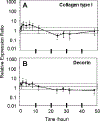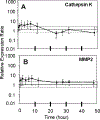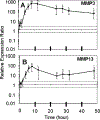Changes in gene expression of individual matrix metalloproteinases differ in response to mechanical unloading of tendon fascicles in explant culture
- PMID: 18404723
- PMCID: PMC6100787
- DOI: 10.1002/jor.20650
Changes in gene expression of individual matrix metalloproteinases differ in response to mechanical unloading of tendon fascicles in explant culture
Abstract
Immobilization of the tendon and ligament has been shown to result in a rapid and significant decrease in material properties. It has been proposed that tissue degradation leading to tendon rupture or pain in humans may also be linked to mechanical unloading following focal tendon injury. Hence, understanding the remodeling mechanism associated with mechanical unloading has relevance for the human conditions of immobilization (e.g., casting), delayed repair of tendon ruptures, and potentially overuse injuries as well. This is the first study to investigate the time course of gene expression changes associated with tissue harvest and mechanical unloading culture in an explant model. Rat tail tendon fascicles were harvested and placed in culture unloaded for up to 48 h and then evaluated using qRT-PCR for changes in two anabolic and four catabolic genes at 12 time points. Our data demonstrates that Type I Collagen, Decorin, Cathepsin K, and MMP2 gene expression are relatively insensitive to unloaded culture conditions. However, changes in both MMP3 and MMP13 gene expression are rapid, dramatic, sustained, and changing during at least the first 48 h of unloaded culture. This data will help to further elucidate the mechanism for the loss of mechanical properties associated with mechanical unloading in tendon.
(c) 2008 Orthopaedic Research Society.
Figures



Similar articles
-
Differential regulation of gene expression in isolated tendon fascicles exposed to cyclic tensile strain in vitro.J Appl Physiol (1985). 2009 Feb;106(2):506-12. doi: 10.1152/japplphysiol.90981.2008. Epub 2008 Nov 26. J Appl Physiol (1985). 2009. PMID: 19036888
-
Patterns of mRNA expression for matrix molecules and growth factors in flexor tendon injury: differences in the regulation between tendon and tendon sheath.J Hand Surg Am. 2006 Oct;31(8):1279-87. doi: 10.1016/j.jhsa.2006.06.011. J Hand Surg Am. 2006. PMID: 17027787
-
Type 2 diabetes impairs tendon repair after injury in a rat model.J Appl Physiol (1985). 2012 Dec 1;113(11):1784-91. doi: 10.1152/japplphysiol.00767.2012. Epub 2012 Oct 4. J Appl Physiol (1985). 2012. PMID: 23042903
-
Fluoroquinolones impair tendon healing in a rat rotator cuff repair model: a preliminary study.Am J Sports Med. 2014 Dec;42(12):2851-9. doi: 10.1177/0363546514545858. Epub 2014 Aug 20. Am J Sports Med. 2014. PMID: 25143490
-
Strain-rate sensitive mechanical properties of tendon fascicles from mice with genetically engineered alterations in collagen and decorin.J Biomech Eng. 2004 Apr;126(2):252-7. doi: 10.1115/1.1695570. J Biomech Eng. 2004. PMID: 15179856
Cited by
-
Release of pro-inflammatory cytokines from muscle and bone causes tenocyte death in a novel rotator cuff in vitro explant culture model.Connect Tissue Res. 2018 Sep;59(5):423-436. doi: 10.1080/03008207.2018.1439486. Epub 2018 Jun 6. Connect Tissue Res. 2018. PMID: 29447021 Free PMC article.
-
Primary cilia are highly oriented with respect to collagen direction and long axis of extensor tendon.J Orthop Res. 2010 Jan;28(1):77-82. doi: 10.1002/jor.20946. J Orthop Res. 2010. PMID: 19603516 Free PMC article.
-
Remodeling and repair of orthopedic tissue: role of mechanical loading and biologics.Am J Orthop (Belle Mead NJ). 2010 Nov;39(11):525-30. Am J Orthop (Belle Mead NJ). 2010. PMID: 21623418 Free PMC article. Review.
-
Fatigue loading of tendon results in collagen kinking and denaturation but does not change local tissue mechanics.J Biomech. 2018 Apr 11;71:251-256. doi: 10.1016/j.jbiomech.2018.02.014. Epub 2018 Feb 21. J Biomech. 2018. PMID: 29519673 Free PMC article.
-
Low-level laser therapy in experimental model of collagenase-induced tendinitis in rats: effects in acute and chronic inflammatory phases.Lasers Med Sci. 2013 May;28(3):989-95. doi: 10.1007/s10103-012-1189-x. Epub 2012 Aug 28. Lasers Med Sci. 2013. PMID: 22926534
References
-
- Matsumoto F, Trudel G, Uhthoff HK, et al. 2003. Mechanical effects of immobilization on the Achilles’ tendon. Arch Phys Med Rehabil 84:662–667. - PubMed
-
- Murrell GA, Lilly EG III, Goldner RD, et al. 1994. Effects of immobilization on Achilles tendon healing in a rat model. J Orthop Res 12:582–591. - PubMed
-
- Binkley JM, Peat M. 1986. The effects of immobilization on the ultrastructure and mechanical properties of the medial collateral ligament of rats. Clin Orthop Relat Res 203:301–308. - PubMed
-
- Almeida-Silveira MI, Lambertz D, Perot C, et al. 2000. Changes in stiffness induced by hindlimb suspension in rat Achilles tendon. Eur J Appl Physiol 81:252–257. - PubMed
-
- Uchida H, Tohyama H, Nagashima K, et al. 2005. Stress deprivation simultaneously induces over-expression of inter-leukin-1beta, tumor necrosis factor-alpha, and transforming growth factor-beta in fibroblasts and mechanical deterioration of the tissue in the patellar tendon. J Biomech 38:791–798. - PubMed
Publication types
MeSH terms
Substances
Grants and funding
LinkOut - more resources
Full Text Sources
Miscellaneous

